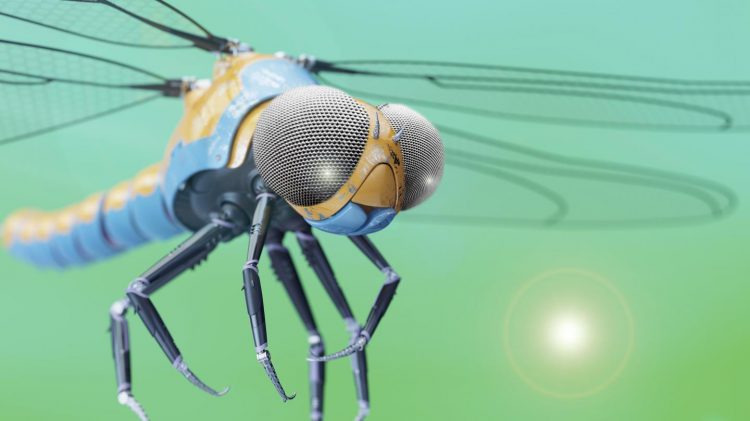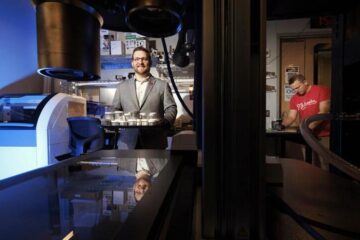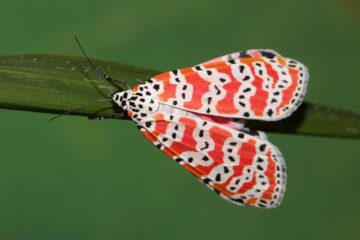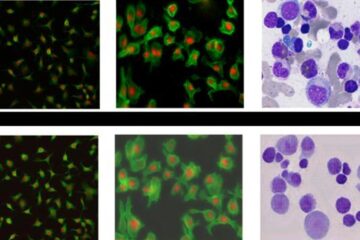New artificial compound eye could improve 3D object tracking

Researchers have created a bio-inspired compound eye that is helping scientists understand how insects sense an object and its trajectory with such speed. The compound eye could also be useful for 3D location systems for robots, self-driving cars and unmanned aerial vehicles. Credit: Le Song, Tianjin University
If you've ever tried to swat a fly, you know that insects react to movement extremely quickly. A newly created biologically inspired compound eye is helping scientists understand how insects use their compound eyes to sense an object and its trajectory with such speed.
The compound eye could also be used with a camera to create 3D location systems for robots, self-driving cars and unmanned aerial vehicles.
In The Optical Society (OSA) journal Optics Letters, researchers from Tianjin University in China report their new bio-inspired compound eye, which not only looks like that of an insect but also works like its natural counterpart. Compound eyes consist of hundreds to thousands of repeating units known as ommatidia that each act as a separate visual receptor.
“Imitating the vision system of insects has led us to believe that they might detect the trajectory of an object based on the light intensity coming from that object rather than using precise images like human vision,” said Le Song, a member of the research team. “This motion-detection method requires less information, allowing the insect to quickly react to a threat.”
Imitating an insect eye
The researchers used a method known as single point diamond turning to create 169 microlenses on the surface of the compound eye. Each microlens had a radius of about 1 mm, creating a component measuring about 20 mm that could detect objects from a 90-degree field of view. The fields of view of adjacent microlenses overlapped in the same way that ommatidia do for most insects.
One of the challenges in making an artificial compound eye is that image detectors are flat while the surface of the compound eye is curved. Placing a light guide between the curved lens and an image detector allowed the researchers to overcome this challenge while also enabling the component to receive light from different angles uniformly.
“This uniform light receiving ability of our bio-inspired compound eye is more similar to biological compound eyes and better imitates the biological mechanism than previous attempts at replicating a compound eye,” explained Song.
To use the artificial compound eye for measuring 3D trajectory, the researchers added grids to each eyelet that help pinpoint location. They then placed LED light sources at known distances and directions from the compound eye and used an algorithm to calculate the 3D location of the LEDs based on the location and intensity of the light.
The researchers found that the compound eye system was able to rapidly provide the 3D location of an object. However, the location accuracy was reduced when the light sources were farther away, which could explain why most insects are nearsighted.
How insects see the world
“This design allowed us to prove that the compound eye could identify an object's location based on its brightness instead of a complex image process,” said Song. “This highly sensitive mechanism suits the brain processing ability of insects very well and helps them avoid predators.”
According to the researchers, the ability of the new bio-inspired compound eye to detect an object's 3D location could be useful for small robots requiring fast detection from a very lightweight system. It also offers a new way for biologists to study the visual systems of insects.
The researchers are planning to imbed the localization algorithm into platforms such as integrated circuits to allow the system to be incorporated into other devices. They are also developing ways to mass produce the compound eye lenses to reduce the unit cost.
###
Paper: Y. Zheng, L. Song, J. Huang, H. Zhang, F. Fang, “Detection of three-dimensional trajectory of object based on curved bionic compound eye,” Opt. Lett., 44, 17, 4143-4146 (2019). DOI: https:/
About Optics Letters
Optics Letters offers rapid dissemination of new results in all areas of optics with short, original, peer-reviewed communications. Optics Letters covers the latest research in optical science, including optical measurements, optical components and devices, atmospheric optics, biomedical optics, Fourier optics, integrated optics, optical processing, optoelectronics, lasers, nonlinear optics, optical storage and holography, optical coherence, polarization, quantum electronics, ultrafast optical phenomena, photonic crystals and fiber optics.
About The Optical Society
Founded in 1916, The Optical Society (OSA) is the leading professional organization for scientists, engineers, students and business leaders who fuel discoveries, shape real-life applications and accelerate achievements in the science of light. Through world-renowned publications, meetings and membership initiatives, OSA provides quality research, inspired interactions and dedicated resources for its extensive global network of optics and photonics experts. For more information, visit osa.org.
Media Contact: mediarelations@osa.org
Media Contact
All latest news from the category: Life Sciences and Chemistry
Articles and reports from the Life Sciences and chemistry area deal with applied and basic research into modern biology, chemistry and human medicine.
Valuable information can be found on a range of life sciences fields including bacteriology, biochemistry, bionics, bioinformatics, biophysics, biotechnology, genetics, geobotany, human biology, marine biology, microbiology, molecular biology, cellular biology, zoology, bioinorganic chemistry, microchemistry and environmental chemistry.
Newest articles

Bringing bio-inspired robots to life
Nebraska researcher Eric Markvicka gets NSF CAREER Award to pursue manufacture of novel materials for soft robotics and stretchable electronics. Engineers are increasingly eager to develop robots that mimic the…

Bella moths use poison to attract mates
Scientists are closer to finding out how. Pyrrolizidine alkaloids are as bitter and toxic as they are hard to pronounce. They’re produced by several different types of plants and are…

AI tool creates ‘synthetic’ images of cells
…for enhanced microscopy analysis. Observing individual cells through microscopes can reveal a range of important cell biological phenomena that frequently play a role in human diseases, but the process of…





















